Ryanair Holdings Bundle
How Does Ryanair Holdings Thrive in the Airline Industry?
Ryanair Holdings, a dominant force in European aviation, has revolutionized air travel with its ultra-low-cost carrier (ULCC) model. Boasting a staggering €13.44 billion in revenue for fiscal year 2024 and serving over 183.5 million passengers, Ryanair's success story is undeniable. Its strategic operational efficiency and aggressive market expansion have solidified its position as a leader in the competitive airline industry.
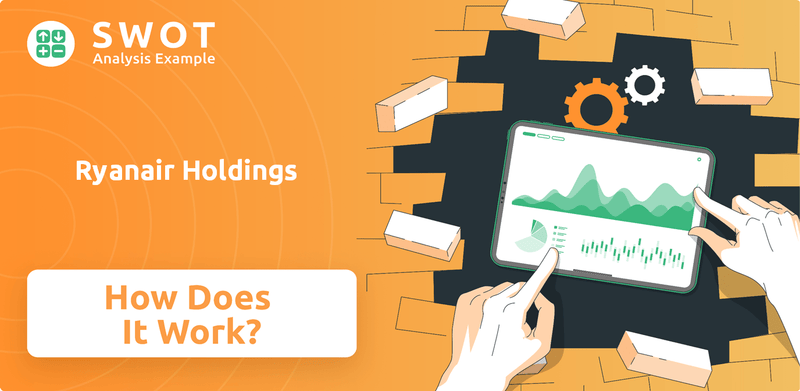
This deep dive into the Ryanair Holdings SWOT Analysis will uncover the secrets behind Ryanair's impressive financial performance, dissecting its core Ryanair business model and Ryanair operations. By exploring its diverse revenue streams and competitive advantages, we'll gain a comprehensive understanding of how this low-cost airline consistently generates profit and impacts European travel. Discover how Ryanair navigates the complexities of the airline industry and continues to expand its influence.
What Are the Key Operations Driving Ryanair Holdings’s Success?
Ryanair Holdings operates as a leading ultra-low-cost carrier (ULCC), primarily serving the European aviation market. Its core business revolves around providing affordable air travel, focusing on short-haul, point-to-point routes. This strategy allows the company to cater to a broad customer base, including leisure and business travelers, by offering exceptionally low fares. The Target Market of Ryanair Holdings is wide, but mostly focuses on those seeking budget-friendly travel options.
The Ryanair business model is built on operational efficiency and cost control. The company's value proposition centers on offering low fares, achieved through a standardized fleet of Boeing 737 aircraft, rapid turnaround times, and direct distribution channels. This approach allows Ryanair to maximize aircraft utilization and reduce operational expenses, which are then passed on to customers in the form of lower ticket prices. Ryanair's operations are designed to minimize costs at every level.
Ryanair's operations are distinguished by their relentless focus on cost control. This includes negotiating favorable deals with airports, optimizing fuel consumption, and minimizing non-essential services. Ryanair's fleet composition, primarily consisting of Boeing 737s, contributes to operational efficiency through simplified maintenance and training. The company's commitment to low fares has significantly impacted the European travel market, making air travel accessible to a wider demographic.
Ryanair's fleet primarily consists of Boeing 737 aircraft, with over 500 aircraft in operation as of early 2024. This standardization simplifies maintenance and reduces operational costs. The airline aims for rapid turnaround times, typically around 25 minutes, maximizing aircraft utilization and reducing airport fees.
Ryanair's financial performance is heavily influenced by its cost control strategies. These include negotiating favorable airport deals, optimizing fuel consumption through hedging strategies, and minimizing non-essential services. In 2024, Ryanair's fuel hedging strategy helped mitigate the impact of fluctuating fuel prices.
Besides ticket sales, Ryanair generates significant revenue from ancillary services. These include baggage fees, priority boarding, and onboard sales. Ancillary revenue streams have become increasingly important, contributing to Ryanair's overall profitability. In 2024, ancillary revenues accounted for a substantial portion of the company's total revenue.
Ryanair's customer service is streamlined, with many services offered as optional add-ons. Distribution is primarily direct through its website and mobile app, reducing reliance on third-party travel agents. This direct approach minimizes commissions and allows for greater control over the customer experience.
Ryanair's success is driven by several key operational strategies focused on efficiency and cost reduction. These strategies enable the airline to offer low fares and maintain profitability in a competitive market.
- Fleet Standardization: The use of a standardized fleet of Boeing 737 aircraft simplifies maintenance, reduces training costs, and increases operational flexibility.
- Rapid Turnaround Times: Quick turnaround times at airports maximize aircraft utilization, reducing costs and increasing the number of flights.
- Direct Distribution: Direct sales through the website and app minimize reliance on third-party agents, reducing distribution costs.
- Ancillary Revenue: Offering optional services like baggage and seat selection generates additional revenue, contributing to overall profitability.
Ryanair Holdings SWOT Analysis
- Complete SWOT Breakdown
- Fully Customizable
- Editable in Excel & Word
- Professional Formatting
- Investor-Ready Format
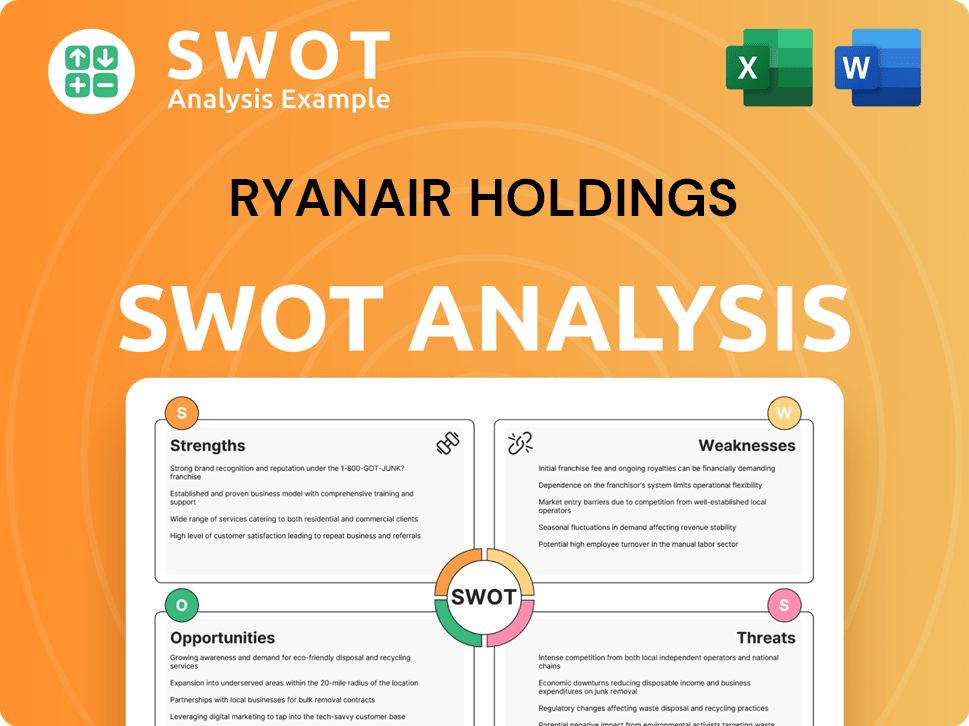
How Does Ryanair Holdings Make Money?
Ryanair Holdings' success is built on a multifaceted revenue strategy that extends beyond just ticket sales. This approach allows the airline to maintain its ultra-low-cost model while maximizing profitability. Understanding how Ryanair generates revenue is key to grasping its position in the European aviation market and its overall financial performance.
The core of Ryanair's revenue comes from scheduled airline ticket sales, which are kept low to attract a high volume of passengers. However, a significant portion of revenue is derived from ancillary services, which has been a growing area of focus for the company. This strategy allows Ryanair to offer competitive base fares while generating additional income from various add-ons.
Ryanair's business model is designed to maximize revenue through several key streams. The primary source is, of course, ticket sales. However, the airline has successfully diversified its revenue streams to include a range of ancillary services, which have become a crucial part of its financial strategy.
Ryanair's initial revenue stream comes from selling airline tickets. These are often priced very low to attract customers. This strategy is a cornerstone of their low-cost airlines business model.
Ancillary revenue is a significant part of Ryanair's income. This includes fees for checked baggage, priority boarding, seat selection, and in-flight services. In fiscal year 2024, this increased by 12% to €4.3 billion, representing approximately 32% of total revenue.
Ryanair uses an 'unbundled' pricing model. The base fare covers the flight only, with nearly all other services offered as optional add-ons. This allows them to advertise low fares while generating extra revenue through upselling.
Ryanair offers different fare classes with varying levels of flexibility and included services. This tiered pricing strategy allows them to cater to different customer needs and preferences, maximizing revenue.
Ryanair generates revenue through advertising on its website and in-flight. They also earn from car hire and hotel bookings facilitated through their platform. This adds to their overall revenue streams.
The company focuses on upselling and cross-selling additional services during the booking process and in-flight. This strategy converts low base fares into higher overall revenue per passenger. This is a crucial part of how Ryanair makes money.
Ryanair's ability to consistently grow its ancillary revenue demonstrates a successful strategy of converting low base fares into higher overall revenue per passenger. For more details, you can read about the Growth Strategy of Ryanair Holdings.
The primary drivers of Ryanair's revenue are ticket sales and ancillary services. The company's operations are designed to maximize revenue from these sources.
- Ticket Sales: Basic fares that attract customers.
- Ancillary Fees: Charges for baggage, seat selection, and other services.
- Advertising: Revenue from ads on their website and in-flight.
- Partnerships: Income from car hire and hotel bookings.
- Upselling: Offering additional services to increase revenue per passenger.
Ryanair Holdings PESTLE Analysis
- Covers All 6 PESTLE Categories
- No Research Needed – Save Hours of Work
- Built by Experts, Trusted by Consultants
- Instant Download, Ready to Use
- 100% Editable, Fully Customizable
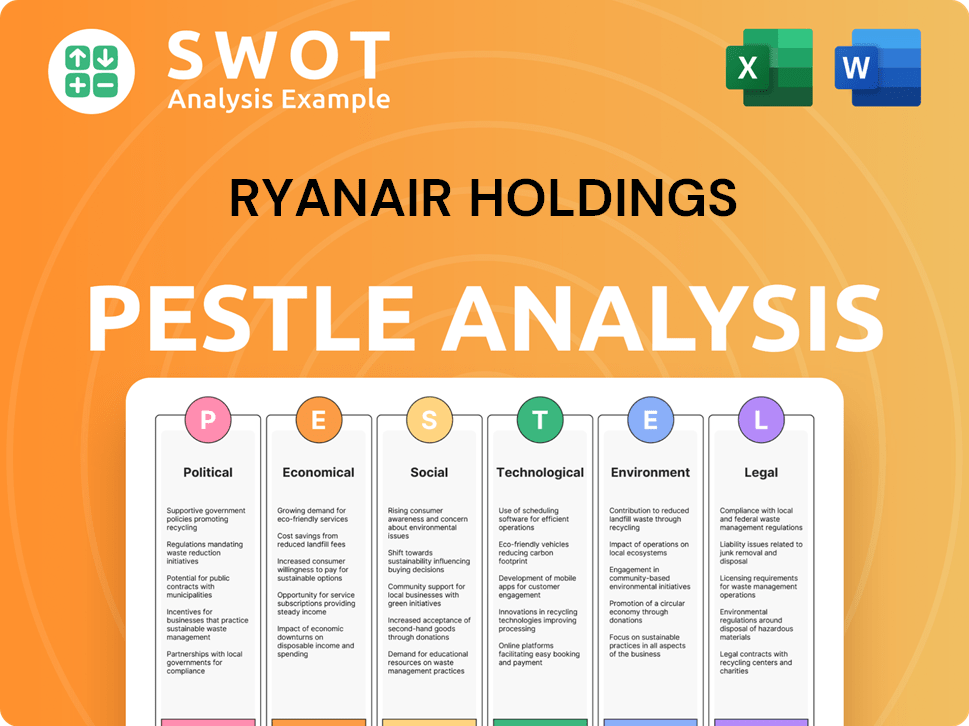
Which Strategic Decisions Have Shaped Ryanair Holdings’s Business Model?
The journey of Ryanair Holdings has been marked by significant milestones that have shaped its operational and financial trajectory. A key strategic move was the widespread adoption of the Boeing 737 fleet in the early 2000s, standardizing operations and reducing maintenance costs. Continuous expansion into new routes and secondary airports across Europe has also been critical, allowing Ryanair to tap into underserved markets and negotiate favorable airport fees. These strategic decisions have been pivotal in establishing Ryanair as a leading low-cost airline.
Ryanair has faced operational challenges, including pilot strikes and air traffic control disruptions, which have impacted flight schedules and customer satisfaction. However, the company has typically responded by strengthening its operational resilience and engaging in direct negotiations with unions to mitigate future disruptions. The airline's ability to adapt and overcome these challenges has been crucial to maintaining its competitive edge. Understanding the Growth Strategy of Ryanair Holdings provides further insights into these adaptive strategies.
Ryanair's competitive advantages are multifaceted, with its unparalleled cost leadership being the most prominent. This is achieved through relentless operational efficiency, high aircraft utilization, and a lean organizational structure. Brand strength, built on its reputation for affordability and an extensive route network, further solidifies its position in the European aviation market. The company continuously adapts to new trends by investing in its digital platforms and exploring sustainable aviation initiatives, ensuring its long-term success.
Ryanair's journey began with a focus on low fares and point-to-point routes. The introduction of the Boeing 737 fleet standardized operations and reduced costs. Expansion into new routes and secondary airports across Europe allowed tapping into underserved markets.
The airline's strategic moves include continuous route expansion and fleet standardization. Investing in digital platforms for seamless booking and ancillary sales has been key. Exploring sustainable aviation fuel (SAF) initiatives shows a commitment to environmental responsibility.
Ryanair's cost leadership is its primary advantage, achieved through operational efficiency. Brand strength, built on affordability and an extensive network, solidifies its market position. Economies of scale allow for better deals with suppliers and airports.
Pilot strikes and air traffic control disruptions have impacted flight schedules. Ryanair responds by strengthening operational resilience. Direct negotiations with unions help mitigate future disruptions.
In 2024, Ryanair carried over 183.7 million passengers, demonstrating its significant market share in the European aviation sector. The airline's load factor consistently remains high, often exceeding 90%, reflecting efficient aircraft utilization. Ryanair's focus on ancillary revenue, such as baggage fees, contributes significantly to its profitability, with ancillary revenue per passenger being a key metric.
- Ryanair's fleet consists primarily of Boeing 737 aircraft, ensuring operational efficiency and cost control.
- The airline continuously expands its route network, focusing on underserved markets and secondary airports to reduce costs.
- Ryanair's commitment to low fares and operational efficiency has made it a leading player in the low-cost airlines industry.
- The company's fuel hedging strategy helps mitigate the impact of fluctuating fuel prices, contributing to its financial stability.
Ryanair Holdings Business Model Canvas
- Complete 9-Block Business Model Canvas
- Effortlessly Communicate Your Business Strategy
- Investor-Ready BMC Format
- 100% Editable and Customizable
- Clear and Structured Layout
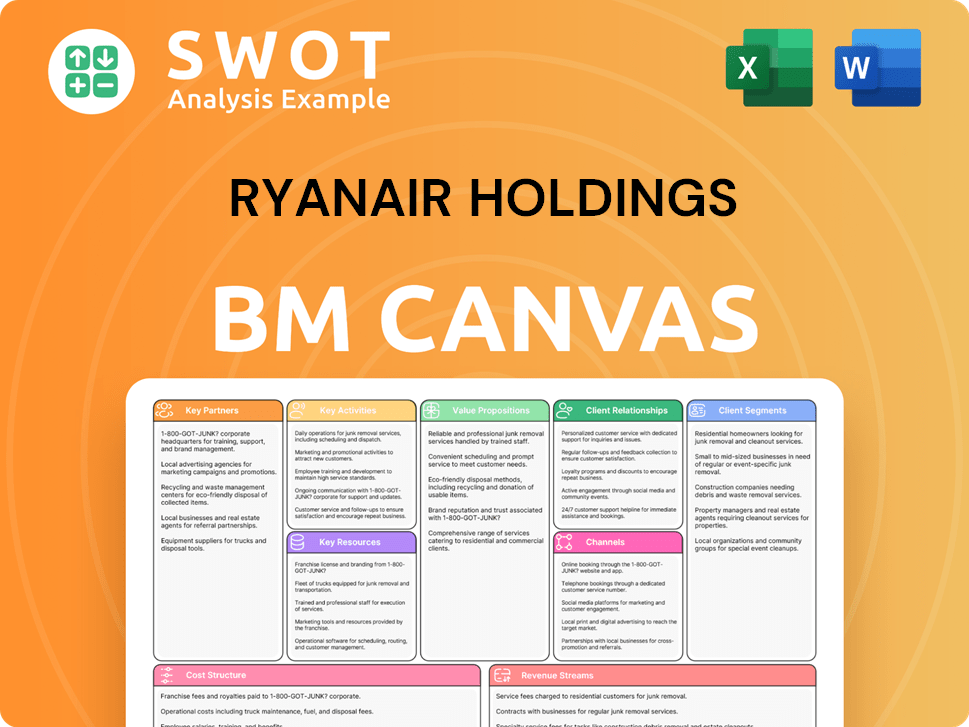
How Is Ryanair Holdings Positioning Itself for Continued Success?
Ryanair Holdings holds a strong position in the European short-haul aviation market. The airline consistently ranks among the top in market share. In fiscal year 2024, Ryanair transported 183.5 million passengers, demonstrating its customer loyalty and extensive European network.
Ryanair business model is characterized by aggressive pricing and an extensive route network, frequently utilizing smaller airports. However, the company faces risks such as regulatory changes, competition from other low-cost airlines, and geopolitical events impacting travel demand. Supply chain issues, particularly in aircraft manufacturing, also pose challenges. Despite these challenges, Ryanair is actively pursuing strategic initiatives to mitigate risks and maintain its competitive edge.
Ryanair maintains a leading position in the European aviation market, particularly in the low-cost segment. Its extensive route network and high passenger volume contribute to its strong market share. The airline's focus on cost efficiency and ancillary revenue generation further solidifies its competitive advantage.
Ryanair operations face risks from regulatory changes, especially those related to environmental regulations and passenger rights. Competition from other low-cost carriers and high-speed rail networks also intensifies price pressure. Geopolitical events and economic downturns can significantly reduce travel demand. Supply chain disruptions, particularly in aircraft manufacturing, pose further challenges.
Ryanair's future outlook involves continued growth in passenger numbers and market share through disciplined cost management and strategic fleet expansion. The company plans to leverage its cost advantage, expand into new markets, and optimize ancillary revenue streams. Investments in fuel-efficient aircraft and digital platforms are key elements of its strategy.
Ryanair's expansion plans include continued investment in its digital platform to enhance customer experience and drive ancillary revenue. The company focuses on cost control to maintain its competitive edge. Investing in new, more fuel-efficient aircraft, like the Boeing 737-8200 'Gamechanger', addresses sustainability concerns.
Ryanair's strategic initiatives focus on cost control, route expansion, and ancillary revenue. The airline aims to maintain profitability by leveraging its cost advantage and expanding its network. The company is also focused on managing external risks and investing in fuel-efficient aircraft to improve sustainability.
- Ryanair's financial performance is closely tied to its ability to manage costs and generate ancillary revenue.
- Ryanair's route network analysis shows a focus on connecting underserved routes and utilizing smaller airports.
- Ryanair's fuel hedging strategy is crucial for managing fuel costs, which is a significant operational expense.
- To learn more about the company, you can read a Brief History of Ryanair Holdings.
Ryanair Holdings Porter's Five Forces Analysis
- Covers All 5 Competitive Forces in Detail
- Structured for Consultants, Students, and Founders
- 100% Editable in Microsoft Word & Excel
- Instant Digital Download – Use Immediately
- Compatible with Mac & PC – Fully Unlocked
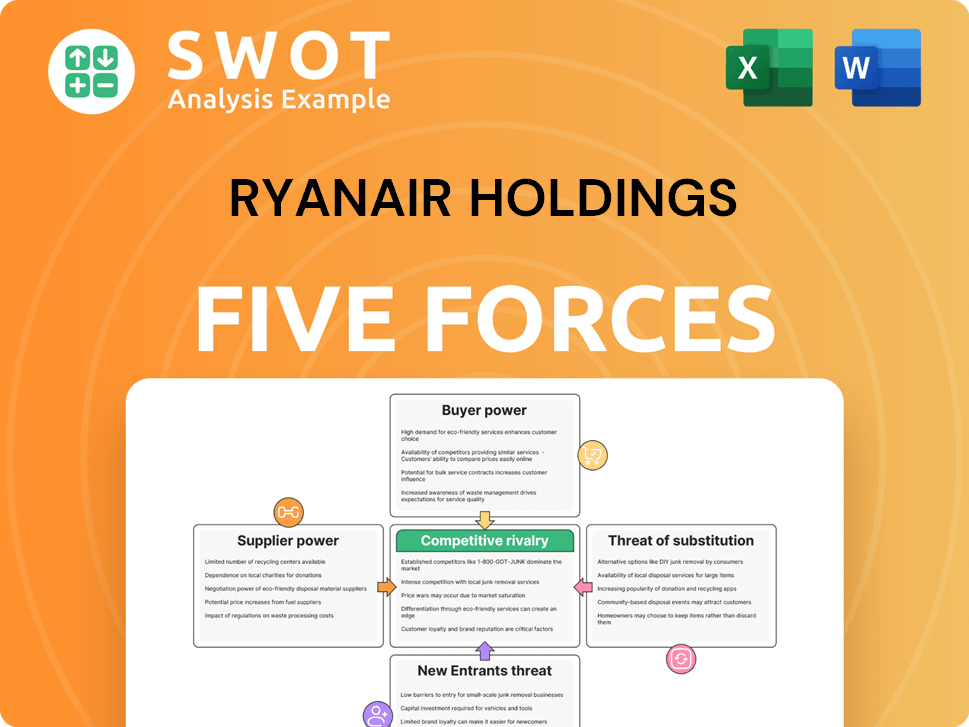
Related Blogs
- What are Mission Vision & Core Values of Ryanair Holdings Company?
- What is Competitive Landscape of Ryanair Holdings Company?
- What is Growth Strategy and Future Prospects of Ryanair Holdings Company?
- What is Sales and Marketing Strategy of Ryanair Holdings Company?
- What is Brief History of Ryanair Holdings Company?
- Who Owns Ryanair Holdings Company?
- What is Customer Demographics and Target Market of Ryanair Holdings Company?
Disclaimer
All information, articles, and product details provided on this website are for general informational and educational purposes only. We do not claim any ownership over, nor do we intend to infringe upon, any trademarks, copyrights, logos, brand names, or other intellectual property mentioned or depicted on this site. Such intellectual property remains the property of its respective owners, and any references here are made solely for identification or informational purposes, without implying any affiliation, endorsement, or partnership.
We make no representations or warranties, express or implied, regarding the accuracy, completeness, or suitability of any content or products presented. Nothing on this website should be construed as legal, tax, investment, financial, medical, or other professional advice. In addition, no part of this site—including articles or product references—constitutes a solicitation, recommendation, endorsement, advertisement, or offer to buy or sell any securities, franchises, or other financial instruments, particularly in jurisdictions where such activity would be unlawful.
All content is of a general nature and may not address the specific circumstances of any individual or entity. It is not a substitute for professional advice or services. Any actions you take based on the information provided here are strictly at your own risk. You accept full responsibility for any decisions or outcomes arising from your use of this website and agree to release us from any liability in connection with your use of, or reliance upon, the content or products found herein.